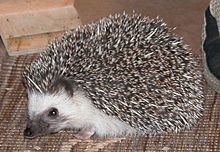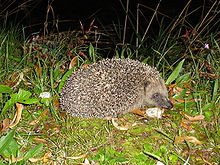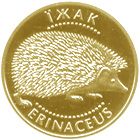Hedgehog
| Hedgehog | ||||||||||||
|---|---|---|---|---|---|---|---|---|---|---|---|---|

Brown-breasted hedgehog ( Erinaceus europaeus ) |
||||||||||||
| Systematics | ||||||||||||
|
||||||||||||
| Scientific name | ||||||||||||
| Erinaceinae | ||||||||||||
| Fisherman , 1814 |
The hedgehogs (Erinaceinae) are a subfamily of the hedgehogs (Erinaceidae). It consists of 16 species in 5 genera that are distributed in Europe , parts of Asia (especially Central and East Asia ) and Africa . They are nocturnal and feed on insects. Characteristic for this group are the long spines.
Occurrence
Hedgehogs live all over the ancient world except for the high latitudes in the Scandinavian countries and Russia. The habitat of the hedgehog is diverse and varies depending on the species, including forests, grasslands, arid areas, rainforests of various types, mountains and increasingly cities, especially European hedgehogs are cultural successors.
anatomy
General
A characteristic of prickly hedgehogs is the prickly dress that stretches from the neck over the back to the tail. The pointed head merges into the compact body without a distinct neck, to which four limbs are attached, the forelimbs developing very strongly into digging. The sole walkers usually only move 100–200 meters an hour, but reach a maximum speed of around 10 km / h and are able to climb and cross high obstacles such as chain link fences. Generally accepted as quiet, they can develop a larger background noise when moving quickly in the undergrowth.
Sensory performances
Hedgehogs have a very powerful sense of sight, smell and hearing, which they can use to find their way around at night. The eyes see very well, but probably in black and white. They mainly rely on smell and hearing. The large olfactory lobes in the brain enable a strong development of the olfactory sense, including a Jacobsonian organ in the palate. Hearing, which is also efficient, has so far only been examined more closely in the long-eared hedgehog ( Hemiechinus auritus ), as it is particularly pronounced in this. This species seems to perceive sounds up to the frequency range of 45 kHz, much higher than in humans with a frequency range of 20 kHz. This means that this species can presumably recognize prey that is active underground, as it usually generates high-frequency noises in the foliage or underground. In the low frequency range, however, hearing deteriorates significantly.
The spiked dress
Characteristic and eponymous for hedgehogs is their prickly dress, which protects them from enemies. A full-grown representative of the hedgehog has an average of 5000 spines, which are very light due to many internal cavities and thus keep the weight of the hedgehog relatively low. Depending on the species, the spines are on average 2–3 centimeters long, dark at the base and light cream-colored towards the tip. They are needle-sharp and developed from hair. This can be seen well on the flanks of these animals: there the thick spines turn into thin spines, these into large, stiff hair and these into normal fur. The spines taper to flexible kinks at the base, whereupon the structure of the spines thickens again into a ball anchored in the skin. This structure of the spines converts pressure on the spines into a bend in the flexible, thin parts of the spines, in order to prevent the spines from being rammed into the hedgehog body when pressure is applied to the spines. When at rest, the spines lie flat against the body; a muscle at the base of the spines can straighten the spines if necessary. When this is the case, the spines cross and support each other.
Way of life
Hedgehogs are generally nocturnal loners.
nutrition
Hedgehogs feed on a variety of invertebrates, including beetles, worms, snails, crickets, grasshoppers, and other invertebrates. In the stomachs and feces of brown-breasted hedgehogs ( Erinaceus europaeus ) there were also indications of the consumption of various vertebrates, for example mice, frogs, shrews, moles, lizards and snakes. The majority of these animals, however, were found and eaten as carrion, meat only makes up a small proportion of the diet of hedgehogs. The food spectrum of hedgehogs changes with age, and over time the animals learn to search for food more efficiently. Adults usually only eat large prey, while young animals specialize in prey of any size. Depending on the species, the proportion of vertebrates in the food spectrum varies considerably; African hedgehogs, long-eared hedgehogs and Asian hedgehogs such as Hemiechinus collaris consume significantly more vertebrates, especially amphibians, reptiles and small rodents. A study on this species showed that vertebrates accounted for 40% of the dry weight of food ingested in the stomach, especially amphibians and mammals made up a large part of it.
Social behavior
Hedgehogs are generally loners, but European hedgehogs, among others, do not defend any territory, many hedgehogs share their range with other conspecifics of any sex. This territorial behavior occurs when vital resources are so unpredictably distributed and varied in amount that the territory would be too large to be effectively defended. Since the invertebrate populations are constantly changing in their distribution and the populations fluctuate greatly, this behavior has developed in the spiny urchins. If food is available in large quantities, especially if it is concentrated in a small area, the animals look for food in close contact, usually they look for food solitary.
Defense and enemies
The fame of hedgehogs stems primarily from their ability to curl up in danger and thus protect themselves from various enemies. They owe their ability to curl up compactly to various body features and muscles: the skin, especially on the back, has a larger area than the surface of the skinless body, it just lies loosely. Furthermore, they have a large muscle on the bag-like skin of the back, the panniculus carnosus , which becomes increasingly strong towards the edge and forms a circular muscle called the orbicularis on the outside . When threatened by a predator, the hedgehog sets up its spines and two small muscles pull the skin over its head and torso. Then the orbicularis contracts, the head and torso are compressed and the prickly skin is pulled over the unborn side, making the hedgehog almost invulnerable. Only a few predatory predators who specialize in hedgehogs can crack down on this method of defense, including large species of owls and the badger . The owls use their long claws to kill hedgehogs, badgers use a different strategy: They are able to stick their snout into the small gap on the belly of a curled up hedgehog and eat it in this way, which usually remains Skin with spines hanging loosely on the hedgehog's body. Since badgers, similar to hedgehogs, also eat earthworms and therefore hunt in the same areas, they occasionally encounter hedgehogs, which they eat opportunistically in this case. Badgers have a large influence on the occurrence of European hedgehog species; Badger odor and badger droppings make otherwise suitable areas for hedgehogs unattractive.
Parasite infestation
Parasite infestation is remarkably high in spiny hedgehogs : Individual animals had more than 1000 fleas , which accordingly weakened these specimens. Other parasites are ticks , mites and fungi. The spines protect hedgehogs from large predators, but make it much more difficult to clean their fur, which makes hedgehogs a good and safe breeding ground for numerous parasites. Hedgehogs are also suitable hosts for many internal diseases and parasite infestations.
Bacterial infections
One of the typical diseases is leptospirosis , which can be transmitted to humans through the urine of infected animals (zoonosis). Also salmonellosis and Koli infections may occur.
Reproduction and development
Hedgehogs show a conspicuous advertisement, which only leads to success in 10% of the cases. The males circle the females, the Algerian hedgehog emits a high-frequency sound. Contrary to the opinion of Aristotle, the pairing does not take place belly to belly, but, as in most mammals, from behind. The female puts on the spines to avoid injury. The males are not monogamous and do not help raise the young. After usually about 35 days, four to five young animals with a weight of 10 to 25 grams are born. When the young are born, the spines are stored in a fluid-filled chamber under the skin so that the female is not injured. The spines emerge after 24 hours, after 2 to three days they can erect, after two to three weeks they can curl up. After six weeks, the young are weaned, and after about a year they are sexually mature.
Immunity to snake venom
A special feature of hedgehogs is their immunity to snake venom: the protein erinacin from the hedgehog's muscles gives it resistance to snake venom. Opossums, mongooses, shrews and moles have similar training.

Systematics
There are five genera with 18 species :
- The small-ear hedgehog ( Erinaceus ) are the largest representatives of the prickly hedgehogs and are the only genus widespread in Central Europe, but they also live in Asia. There are four types:
- The brown-breasted hedgehog ( Erinaceus europaeus ) lives in Western Europe and is one of the two species commonly known as the "European hedgehog".
- The northern white-breasted hedgehog ( Erinaceus roumanicus ) is the other European, but in this case Eastern European species, known under the common name "European hedgehog".
- The southern white-breasted hedgehog ( Erinaceus concolor ) is a species of hedgehog native to the Middle East and the southern Caucasus.
- The Chinese hedgehog ( Erinaceus amurensis ) lives in East Asia and is the least known species of its genus.
- The African hedgehogs ( Atelerix ) are mostly native to Africa and are closely related to the small ear hedgehogs . There are four types:
- The white-bellied or African dwarf hedgehog (A. albiventris ) is native to all of Central Africa (from Senegal and Sudan to Zambia).
- The Kapigel (A. frontalis ) lives in southern Africa (from Angola and Zimbabwe to South Africa).
- The Algerian or North African hedgehog (A. algirus ) occurs in northern Africa (Morocco to Libya) and on the Mediterranean coast of Spain. The species was introduced in southern France and the Canary Islands.
- The Somali hedgehog (A. sclateri ) lives in northern Somalia.
- The steppe hedgehog ( Mesechinus ) comprise four species that live in Mongolia , southeast Russia and northern China .
- The Daurian hedgehog (M. duricus ) lives in Mongolia (Gobi Desert), in south-eastern Russia (Transbaikalia) and in northern China (Inner Mongolia, western Manchuria).
- Hugh's hedgehog (M. hughii ) lives in the Chinese provinces of Shaanxi and Shanxi .
- Mesechinus miodon lives in northern Shaanxi.
- Mesechinus wangi occurs in southwestern Yunnan .
- The long-eared hedgehogs ( Hemiechinus ) are, as the name suggests, characterized by their large ears. Their range extends from North Africa to Central Asia and India .
- The (real) long-eared hedgehog (H. auritus ) occurs from Libya and Egypt via Asia Minor and Arabia to Central Asia and Mongolia (Gobi Desert).
- The Indian long-eared hedgehog (H. collaris ) lives in the Indus valley and adjacent areas in Pakistan and northern India.
- The desert hedgehogs ( Paraechinus ) comprise four species that inhabit arid areas in North Africa, Southwest and Central Asia, and India.
- The Ethiopian hedgehog (P. aethiopicus ) lives in northern Africa (from Morocco and Mauritania to Somalia) and on the Arabian Peninsula.
- The Indian hedgehog (P. micropus ) is found in Pakistan and northwestern India.
- Brandt's hedgehog (P. hypomelas ) lives in Iran and Central Asia (in the Aral Sea area) and occasionally in the Indus Valley and on the Arabian Peninsula.
- The naked-bellied hedgehog (P. nudiventris ) lives in only a small area in south-western India (Kerala, Tamil Nadu).
Man and hedgehog
Hedgehogs in art and culture

Various representations of hedgehogs can be found in ancient cultures, including in fairy tales. Various representations of hedgehogs can also be found on coats of arms as well as on coins. The brown-breasted hedgehog in particular plays a role in various stories.
threat
Hedgehogs today are threatened by various factors, including the fragmentation of their habitat and the risk of being run over on the streets. Environmental toxins continue to affect them.
Pet ownership
The native brown-breasted hedgehogs are protected by law in Germany and other countries and may not be kept as pets . Animal welfare organizations also reject the keeping of other hedgehog species in captivity, as the care and nutrition of nocturnal animals is demanding and keeping them in cages or terrariums would not do justice to their high urge to move. However, exotic hedgehogs, especially the African dwarf hedgehog, are kept as pets from time to time.
literature
- Ronald M. Nowak: Walker's Mammals of the World. 2 volumes. 6th edition. Johns Hopkins University Press, Baltimore MD et al. 1999, ISBN 0-8018-5789-9 .
- Carlo Rondinini, Andrew Wroot: Hedgehogs and Hedgehogs. In: David Macdonald (ed.): The great encyclopedia of mammals. Könemann in the Tandem-Verlags-GmbH, Königswinter 2004, ISBN 3-8331-1006-6 , pp. 734-741 (German translation of the English original edition from 2001).
Individual evidence
- ↑ Online editorial office Pro Igel Association for Integrated Nature Conservation Germany eV: Pro Igel Association for Integrated Nature Conservation Germany eV: Exotic hedgehogs as pets. In: www.pro-igel.de. Retrieved December 10, 2016 .






